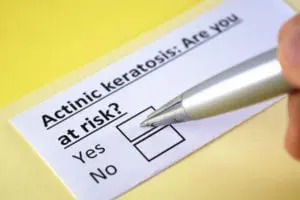Actinic keratosis is a scaly, rough patch that develops on your skin as a result of prolonged sun exposure. It appears on the lips, face, scalp, forearms, back of hands, or neck. If there is a spot on your skin that you think could potentially be an actinic keratosis, schedule a skin exam immediately. Getting timely diagnosis and treatment can reduce the risk of skin cancer and also help ease symptoms such as pain or itch.
How Is Actinic Keratosis Diagnosed?
 A certified dermatologist will first examine your skin and ask questions related to your medications, symptoms, and overall health. If you have actinic keratosis on your skin, a dermatologist will be able to diagnose it immediately.
A certified dermatologist will first examine your skin and ask questions related to your medications, symptoms, and overall health. If you have actinic keratosis on your skin, a dermatologist will be able to diagnose it immediately.
They may also look for any potential signs of skin cancer. People with actinic keratosis whose skin has been damaged severely due to UV light are at a much higher risk of developing skin cancer.
For some people, dermatologists simply recommend more skin exams instead of treatment, especially if treatment poses a threat of further complications. Effective treatment should be able to destroy all the actinic keratosis on your skin.
Actinic Keratosis Treatment
The right treatment for you depends on many factors such as:
- The amount of AKs you have
- The location of the AKs
- The appearance
- Whether you previously had skin cancer
- Additional medical conditions
Here are different options for treating actinic keratosis:
Cryosurgery
Cryosurgery is a popular actinic keratosis treatment where your dermatologist freezes the patches using specialized equipment. The goal is to make the actinic keratosis fall off in a few days. However, in some cases, you may need more than a single cryosurgery session for better results.
The procedure involves applying a cold substance to your patch. Following the procedure, you may see a blister on the treated area, which is normal.
Chemical Peel
A chemical peel is another treatment used to destroy your skin’s top layer. Following the procedure, your skin may be swollen, sore, and red. As the area begins to heal, you will see healthy skin appearing.
Photodynamic Therapy
This actinic keratosis treatment is usually recommended for people who continue to develop new AKs or witness AKs returning after treatment. However, since the treatment is administered in two steps, it can be a bit time-consuming.
In the first part, a solution is applied to the target area for a good 60 to 90 minutes, following which you are treated with either a red or blue light. Once the light activates the solution, the AKs can be destroyed.
You will be required to avoid going outdoors, especially during the day, for at least 48 hours after treatment. Even on a cloudy or snowy day, UV light can cause your skin to react adversely.
Your dermatologist will suggest ways to protect your skin till you can get home safely. Usually, the second photodynamic therapy treatment is given three weeks after the first one.
Curettage
If your actinic keratosis is extremely thick, curettage may be the right choice of treatment for you. The procedure involves your dermatologist scraping the AK from your skin. They may use electrodesiccation after the procedure to heal the treated area and destroy remaining AK cells.
Laser Resurfacing
Laser resurfacing is often used for actinic cheilitis, which is a precancerous growth on your lip. The procedure involves removing your skin’s surface layer. Your skin may feel sore and raw after treatment; however, you will see healthier skin once it begins to heal in a few weeks.
Actinic Keratosis Treatment at Home
Some dermatologists also recommend at-home treatments. However, they are only done in rare circumstances. At-home treatments usually involve the use of medication as directed by your dermatologist.
When it comes to treating your AKs, using medication has many advantages. One of the biggest is that it reduces your risk of developing skin cancer.
However, a downside is that many patients find it hard to follow the treatment plan. For the medication to be effective, you must follow the directions you dermatologist prescribes. Even if it causes a skin reaction, you should keep applying the medication.
Most dermatologists recommend the following medications approved by the US FDA (Food and Drug Administration).
- 5-fluorouracil (5-FU) cream:The cream is applied once or twice a day for up to 4 weeks. It can be applied to the arms, chest, or back but not the face as it can cause a skin reaction. However, it is not recommended for pregnant women.
- Diclofenac sodium gel:As compared to the 5-FU, this medication causes less of a skin reaction and can still be effective. It is recommended to apply this gel at least twice a day for up to 3 months. Make sure to protect your treated skin from sun exposure by following your dermatologist’s advice.
- Imiquimod cream:Imiquimod cream is a great option for your face and can be applied once or twice a week, so you don’t get crusting or redness. Your dermatologist may recommend applying it for up to 16 weeks.
However, if you think that the duration is too long, you can request a different plan. Sometimes, a professional may prescribe both medication and procedure to treat your actinic keratosis effectively. Don’t try to calm your treated skin using any corticosteroid medication as they may prevent your AK treatment from being effective.
In conclusion, there are many ways to treat your actinic keratosis. However, the final decision should be based on your consultation with a dermatologist, who will determine a solution based on your medical history and the severity of your condition.

Recent Comments